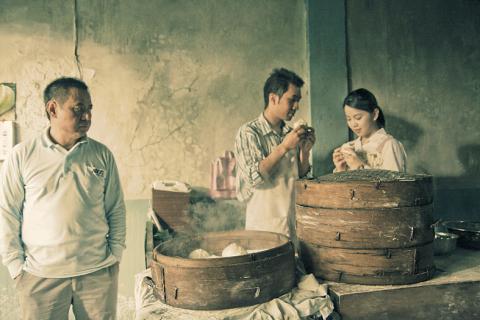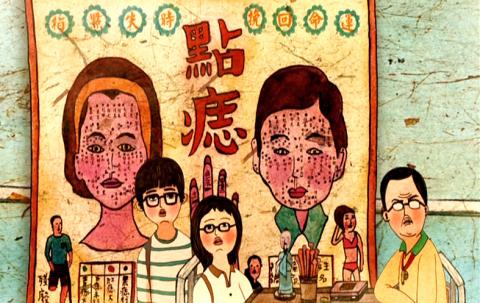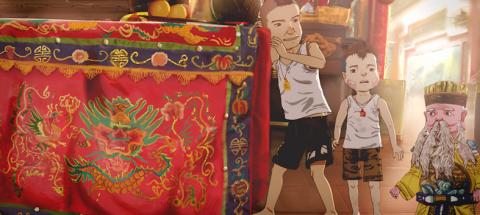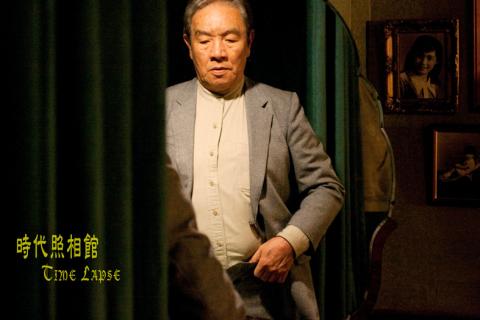Taiwanese cinema is experiencing a revival. University film courses are expanding and becoming more popular and young filmmakers are making their presence felt. In another sign of an emerging cinematic renaissance, entries to the Golden Harvest Awards (金穗獎) have risen from 115 in 2008 to 215 this year.
“The Golden Harvest has grown from a small event to an arena of competition between filmmakers,” said film critic Tien Kuo-ping (田國平), who is also known as Pin Chiung Nan (貧窮男).
Fifty selected films will compete in five categories (fiction, animation, documentary, experimental and student films) for a total of NT$3 million in prize money at this year’s Golden Harvest Awards.

Photo Courtesy of Chinese Taipei Film Archive
The awards ceremony will take place at the Plum Wine Factory (烏梅酒廠), Huashan 1914 Creative Park (華山1914), on March 25.
As well as more entrees than previous editions, the quality of the films has risen, said Tien. Animation in particular continues to grow more mature and polished in terms of technique and styles, eclipsing contenders in the feature, documentary and experimental sections, said Tien, though he added that the role of storytelling often takes a back seat.
Covering a gamut of topics from history and Aboriginal culture to the environment and biography, the documentary category nominees are diverse in subject matter but offer few surprises and lack developed viewpoints, according to Tien.

Photo Courtesy of Chinese Taipei Film Archive
Experimental cinema, as usual, occupies an obscure corner of the annual competition, whose jury members are mostly film professionals and scholars who may not be familiar with experimental filmmaking techniques.
The festival runs until March 27, after which it will tour the rest of the country until May 13. For more information, visit the event’s Web site at www.movieseeds.com.tw or its blog at gha33.pixnet.net/blog.
Awards highlights

Photo Courtesy of Chinese Taipei Film Archive
Crossing the sentiMENtal Desert (焉知水粉)
Who says a student film can’t boast a top-notch cast? This graduation project, by Chang Teng-yuan (張騰元) from Shih Hsin University (世新大學), stars celebrated thespian Tsai Chen-nan (蔡振南) and polished film and theater actor Huang Jian-wei (黃健瑋) as a father (Tsai) and son (Huang) who become estranged after a young Vietnamese woman is hired to help out at the parent’s steamed bun shop.

Photo Courtesy of Chinese Taipei Film Archive
Magabahai (馬嘎巴海)
Music and the sounds of Nature are the biggest draws of this feel-good movie about friendship between an Amis tribe elder and an American cyclist. The fact that director Patrick Tu (杜均堂) is the son of renowned recording artist Tu Duu-chih (杜篤之) explains why the sound track is of such high quality. The film won the Best Short Film Golden Horse Award last year, which should be an inspiration to budding filmmakers.
The Other Side

Photo Courtesy of Chinese Taipei Film Archive
In this whimsically dark animation, female director Chen Chiu-ling (陳秋苓) paints a brooding portrait of one woman’s experience of growing up, breaking free from her domineering mother and escaping to the “other side” of the ghostly town in which she lives.
Time of Cherry Blossoms (櫻時)
Taiwan’s folk beliefs come to life in this well-crafted animation, which tells the tale of a boy who is accompanied on an adventure by celestial beings. The film shows a surprisingly mature style reminiscent of late Japanese animator Satoshi Kon’s works and is regarded as one of the strongest contenders in the Golden Harvest Awards’ best animation category.
Time Lapse (時代照相館)
This 30-minute film touches on the themes of life, death and memory through a bittersweet tale about an aging photographer, played by veteran actor Ting Chiang (丁強), and four teenage boys. Blessed with a polished script, smooth cinematography and emotive performances, Time Lapse has got off to a good start at this year’s Golden Harvest by winning a recommendation award, which is judged by bloggers and was introduced to the festival in 2007.

Most heroes are remembered for the battles they fought. Taiwan’s Black Bat Squadron is remembered for flying into Chinese airspace 838 times between 1953 and 1967, and for the 148 men whose sacrifice bought the intelligence that kept Taiwan secure. Two-thirds of the squadron died carrying out missions most people wouldn’t learn about for another 40 years. The squadron lost 15 aircraft and 148 crew members over those 14 years, making it the deadliest unit in Taiwan’s military history by casualty rate. They flew at night, often at low altitudes, straight into some of the most heavily defended airspace in Asia.

Many people in Taiwan first learned about universal basic income (UBI) — the idea that the government should provide regular, no-strings-attached payments to each citizen — in 2019. While seeking the Democratic nomination for the 2020 US presidential election, Andrew Yang, a politician of Taiwanese descent, said that, if elected, he’d institute a UBI of US$1,000 per month to “get the economic boot off of people’s throats, allowing them to lift their heads up, breathe, and get excited for the future.” His campaign petered out, but the concept of UBI hasn’t gone away. Throughout the industrialized world, there are fears that

Like much in the world today, theater has experienced major disruptions over the six years since COVID-19. The pandemic, the war in Ukraine and social media have created a new normal of geopolitical and information uncertainty, and the performing arts are not immune to these effects. “Ten years ago people wanted to come to the theater to engage with important issues, but now the Internet allows them to engage with those issues powerfully and immediately,” said Faith Tan, programming director of the Esplanade in Singapore, speaking last week in Japan. “One reaction to unpredictability has been a renewed emphasis on

Taiwan’s democracy is at risk. Be very alarmed. This is not a drill. The current constitutional crisis progressed slowly, then suddenly. Political tensions, partisan hostility and emotions are all running high right when cool heads and calm negotiation are most needed. Oxford defines brinkmanship as: “The art or practice of pursuing a dangerous policy to the limits of safety before stopping, especially in politics.” It says the term comes from a quote from a 1956 Cold War interview with then-American Secretary of State John Foster Dulles, when he said: ‘The ability to get to the verge without getting into the war is